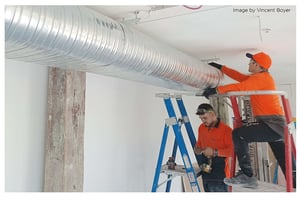As your business evolves, it makes sense that your work environment does too. The world of work is changing and a regular analysis of business operations is essential to ensure that the workspace still supports your future vision and your team.
Here are the key steps to a successful office refurbishment:
-
Select an internal stakeholder project team As well as selecting a project lead, it is important to involve project stakeholders from across the business as it is likely that different departments will have varying concerns about how the workspace operates. This will also promote ‘buy-in’ across the wider business as they feel their concerns are being considered and addressed.
-
Select a fitout partner to deliver your project Selecting a partner you can work closely with, and who will provide honest and transparent guidance is essential. Select a firm that not only has proven experience and favourable client testimonials but a partner who can offer you a variety of delivery models to suit your specific brief and requirements. Whereas the most popular model is a traditional design & construct (D&C) which involves a full turnkey solution managed by the fitout partner, it is worth discussing other options.
-
Identify your ‘Why’ The drivers and objectives for change will differ for every client and every project. The overall goals can be diverse and can cover elements such as company growth or contraction, internal challenges around team culture and productivity, the suitability of the IT infrastructure or perhaps that your current office doesn’t represent your brand and company values.
-
Budget & Programme This element can be problematic for companies that have not undertaken a refurbishment project previously. If there is already a budget in mind, a fitout partner can advise what level of specification can be achieved and ensure the alignment of the objectives with the budget. By working with transparency and open dialogue, a solution that works for all parties can be agreed upon before any construction begins to guarantee there are no unexpected fees as the project progresses.
-
Space planning A refurbishment provides the opportunity to analyse how your teams collaborate and use the current space. By reviewing your employee attendance rates, you can assess whether the SQM size still suits your business size, even if the current layout presents challenges. By engaging the wider team, you can discover what work settings, formal meeting rooms and informal teamwork areas would be beneficial to promote collaboration and innovative work.
-
Staff Morale Studies have shown that the majority of employees have missed the social aspect of attending the office in the last 2 years. Spaces that can encourage social interaction such as chill-out and breakout areas are essential to maintaining a genuinely connected team and can often double as town hall areas for company gatherings.
-
Flexible Settings The future is flexible, and selecting flexible settings that can be moved and adapted as the business needs change could be a better option than fixed built environment. In reality, the majority of meetings do not require strict privacy in enclosed meeting rooms. A variety of tech-enabled furniture or settings can be an ideal alternative.
-
Sustainable Re-use or recycle A design and fitout partner can assist with an audit of the current space, built environment and furniture to see if there are opportunities to reuse or recycle current equipment. Part of the value engineering process is to ensure that clients receive the best solution for the best cost, and re-purposing current assets can release additional budget for other areas of the fitout.
-
Tech upgrades The world of work moving forward is hybrid. Your workplace must have the ability to support remote work and open communication between teams. Improvement of technology infrastructure can be a costly process, so it is essential to identify what is required before renewing a lease.
-
Does the building have amenities & facilities? Attraction and retention of the best team is an important consideration, both from the tenancy and from the building as a whole. Expectations around amenities and facilities are prevalent in the workforce, so the more features that can be offered, the better.
-
Staging to avoid business disruption If you plan to occupy the tenancy during the refurbishment, is there an opportunity for staging and site arrangement where the team can continue to work around the works, or is the business set up for employees to effectively work remotely? This is important to avoid any costs associated with temporary office space and to avoid any disruption to operations.
Click here to talk to us now about how we can assist you in your refurb office fitout journey.

-Emailfooter.png?width=100&height=82&name=TRUE%20(White%20Trans)-Emailfooter.png)
